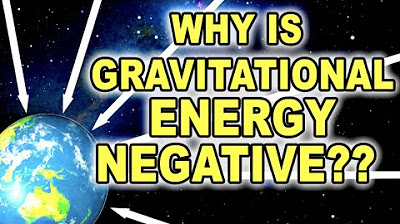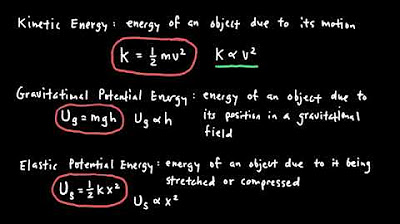Mr Chua, can you explain the F=-dU/dx formula?
TLDRThe video script explains the concept of work and potential energy in a clear and engaging manner. It emphasizes the relationship between force, work, and potential energy, highlighting how external forces and field forces interact to change an object's potential energy. Using examples like gravitational and elastic potential energy, the script illustrates how the energy gradient on a graph can inform us about the forces at play. It also discusses the dynamics of a spacecraft's gravitational potential energy between the Earth and the Moon, showing how the energy gradient can indicate the resultant gravitational force and its direction.
Takeaways
- 📘 Work Done Formula: Work done (W) is calculated as the force (F) applied through a distance (s), represented as W = F × s.
- 🔼 Constant Force: When a constant force is applied, work is done at a constant rate, and the graph of force versus distance shows a steeper incline with stronger forces.
- ⚡ Energy Gradient: The energy gradient, or the gradient of the force graph, corresponds to the force applied (F), measured in joules per meter (J/m).
- 🌐 Potential Energy and External Force: To increase potential energy, an external force must do positive work against a field force, such as gravitational or electric force.
- 🔄 Field Force Relationship: The field force (like gravity) is always in the opposite direction to the external force, making the potential energy gradient negative relative to the field force.
- 📈 Gravitational Potential Energy (GPE): In the case of GPE, the external force (upward) must match the gravitational pull (downward) to move a mass to a higher position without gaining kinetic energy.
- 📊 GPE Graph: A graph of GPE against height (H) results in a straight line, with the gradient representing the external force (mg) and the negative gradient representing the gravitational force (mg).
- 🔄 Patterns in Forces: The external force always points towards higher potential energy, while the field force pulls towards lower potential energy.
- 🌉 Elastic Potential Energy (EPE): To increase EPE in a spring, an external force must be exerted in the opposite direction of the spring force, increasing proportionally to the extension (Hooke's Law).
- 🚀 Spacecraft GPE: The GPE of a spacecraft between Earth and the Moon can be analyzed by considering the resultant gravitational pull, which is determined by the energy gradient on the graph.
- 📈 Interpreting Energy Graphs: The steepness of the energy gradient on a graph indicates the magnitude of the resultant force, with steeper gradients corresponding to stronger forces.
Q & A
What is the basic concept of work done in physics?
-In physics, work done is the product of a force (F) applied to an object and the distance (s) it moves in the direction of the force. It is represented by the formula: work = F × s.
How does the strength of a force relate to the energy gradient in a graph?
-The steeper the graph, the stronger the force. The energy gradient, which is the slope of the graph, corresponds to the force, represented in units of joules per meter (J/m).
What is the relationship between potential energy and the external force doing positive work?
-Potential energy is related to the external force doing positive work on an object. The external force increases the potential energy by working against the field force, which is the force that opposes the motion (like gravitational or electric force).
How does the direction of the external force relate to the direction of potential energy change?
-The external force is always in the direction of higher potential energy. It points towards where the potential energy will be higher because positive work done by the external force increases the potential energy.
What is the relationship between the potential energy gradient and the field force?
-The negative of the potential energy gradient is equal to the field force. This means that the field force is always in the opposite direction to the potential energy gradient, trying to pull the object towards lower potential energy.
How does the external force required to move a mass to a higher position relate to gravitational pull?
-To move a mass to a higher position, you need to exert an upward external force to overcome the downward gravitational pull. The external force must match the gravitational pull exactly to ensure that the work done increases gravitational potential energy without imparting kinetic energy to the mass.
What is the relationship between the energy gradient and the external force in the context of elastic potential energy?
-In the case of elastic potential energy, the external force required to stretch a spring is proportional to the extension (X) and is in the opposite direction to the spring force. The energy gradient corresponds to the external force, and the negative gradient corresponds to the spring force, indicating the force's direction.
How can the potential energy graph of a spacecraft between Earth and the Moon indicate the resultant gravitational pull?
-The potential energy graph shows the total gravitational potential energy (GPE) of the spacecraft and the gradients indicate the resultant gravitational pull. The direction of the steepest increase in GPE indicates the direction of the stronger gravitational pull and thus the resultant force's direction.
What happens at the point where the energy gradient is zero in the potential energy graph?
-At the point where the energy gradient is zero, the gravitational pull is effectively zero. This means that the leftward pull of one body (like Earth) is exactly matched by the rightward pull of another (like the Moon), resulting in a balance of forces.
How can the steepness of the graph in a potential energy diagram indicate the magnitude of the resultant force?
-The steepness of the graph in a potential energy diagram is directly related to the magnitude of the resultant force. A steeper gradient indicates a stronger resultant force, as it represents a greater change in potential energy over a given distance.
What is the significance of understanding the relationship between potential energy, external forces, and field forces?
-Understanding these relationships is crucial for analyzing and solving problems in mechanics, particularly those involving changes in potential energy. It helps in determining the forces required to move objects, the energy transformations, and the stability of systems.
Outlines
📚 Understanding Work and Energy Concepts
This paragraph introduces the fundamental concept of work done in the context of force and distance. It explains that work is represented as the product of force (F) and distance (s), and how this relates to potential energy. The discussion then moves to constant forces and the energy gradient, emphasizing the relationship between force and the steepness of the gradient in a graph. The paragraph further delves into potential energy, differentiating between the roles of external forces and field forces, such as gravitational and electric forces, in doing positive work to increase potential energy and their opposition to each other. The equations and concepts are clarified with the potential energy gradient being equal to the external force and the field force being the negative of the potential energy gradient.
🚀 Applying Concepts to Gravitational and Elastic Potential Energy
This paragraph builds upon the previous discussion by applying the concepts to real-world examples of gravitational and elastic potential energy. It starts with the example of gravitational potential energy (GPE), explaining how an external force must overcome the downward gravitational pull to increase GPE. The relationship between the external force and the gravitational force is highlighted, with the graph of GPE against height illustrating the concept of energy gradient corresponding to the external force. The paragraph then shifts to elastic potential energy, discussing how an external force must be proportional to the spring force to stretch the spring without kinetic energy exchange. The energy gradient in this case is related to the external force and the spring force, with the pattern observed being that the external force always points towards higher potential energy, while the field force pulls towards lower potential energy.
🌌 Analyzing the Gravitational Pull of Earth and Moon on a Spacecraft
The final paragraph of the script extends the concept of potential energy and energy gradients to a more complex scenario involving the gravitational pull of Earth and the Moon on a spacecraft. It illustrates how the gradients on a graph of the spacecraft's gravitational potential energy can inform us about the resultant gravitational force. The discussion includes the impact of the spacecraft's position on the direction and strength of the resultant gravitational force, with the Earth's and Moon's gravitational pulls being compared. The paragraph explains how the external force required to increase the spacecraft's gravitational potential energy depends on its current position relative to Earth and the Moon. It also touches on the point where the energy gradient is zero, indicating a balance between Earth's and Moon's gravitational pulls. The summary emphasizes the importance of understanding the steepness of the energy gradient graph to determine the magnitude of the resultant force and concludes with a hope that the explanations provided are useful for understanding the relationship between potential energy graphs and field forces.
Mindmap
Keywords
💡Work Done
💡Constant Force
💡Energy Gradient
💡Potential Energy
💡Field Force
💡Gravitational Potential Energy (GPE)
💡Elastic Potential Energy (EPE)
💡External Force
💡Hooke's Law
💡Resultant Force
💡Steepness of the Graph
Highlights
Work done is equal to force F times distance s, indicating that a force can do work on an object.
For constant force, work is done at a constant rate, and the stronger the force, the steeper the graph.
The energy gradient or the gradient of the graph corresponds to the force in joules per meter.
In potential energy discussions, an external force does positive work to increase potential energy against a field force.
The negative of the potential energy gradient is equal to the field force, showing the relationship between energy gradients and forces.
The external force is always in the opposite direction to the field force, which is a key concept in understanding potential energy scenarios.
The concept of gravitational potential energy is introduced, where the external force must overcome the downward gravitational pull.
The external force required to move a mass to a higher position must match the gravitational pull exactly.
The graph of gravitational potential energy (GPE) plotted against height H is a straight line, representing the constant rate of work done.
The energy gradient corresponds to the external force, which is equal to mg in the case of gravitational potential energy.
An important pattern is that the external force always points to a higher potential energy, while the field force pulls towards lower potential energy.
Elastic potential energy is discussed, with the need to exert an external force to increase it against the spring force.
The external force for a spring is proportional to the extension of the spring, following Hooke's law.
The work done by the external force increases quadratically for elastic potential energy, going into the energy storage.
The energy gradient for elastic potential energy corresponds to the external force, and the negative gradient corresponds to the spring force.
A spacecraft's variation of gravitational potential energy between Earth and the Moon is used as an example to explain the resultant gravitational pull.
The maximum point on the graph where the energy gradient is zero indicates a balance between gravitational pulls.
The steepness of the graph indicates the magnitude of the resultant force, providing insights into the strength of gravitational pulls.
Transcripts
Browse More Related Video

Gravitational Potential Questions | A Level Physics | Formulas, Key Words, Graphs

Potential Energy and Conservative Forces - Gradient Vectors | Physics | Calculus

Why is Gravitational Potential Energy Negative? (Gravity, Physics)

What is Gravitational Potential Energy - a deeper understanding

AP Physics 1 Energy Review

Calculating gravitational potential energy | Modeling energy | High school physics | Khan Academy
5.0 / 5 (0 votes)
Thanks for rating: